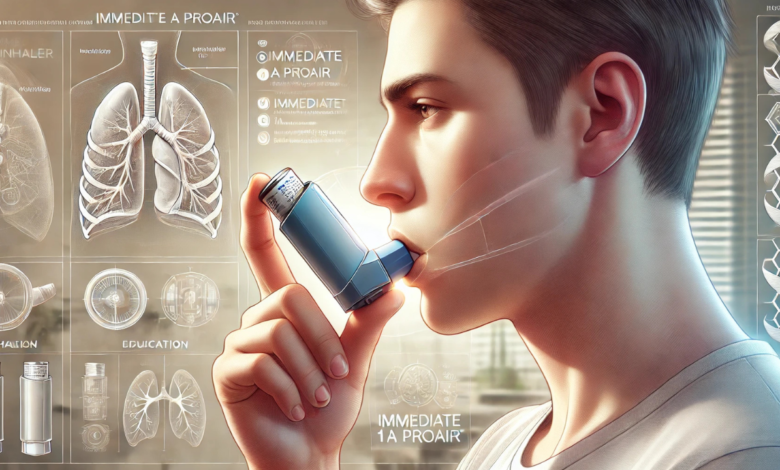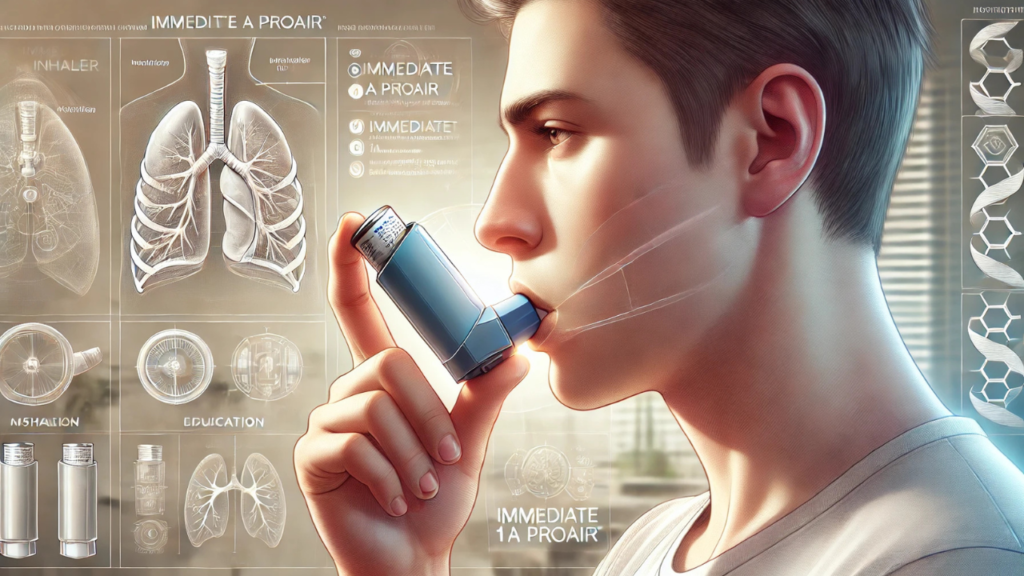Understanding Immediate 1A Proair: A Comprehensive Guide

Introduction
Immediate 1A Proair is a widely used medication designed to help individuals with asthma, chronic obstructive pulmonary disease (COPD), and other respiratory conditions. Its primary function is a fast-acting bronchodilator, which helps relax the muscles around the airways, making breathing easier during an asthma attack or other acute respiratory conditions. For many, Immediate 1A Proair has become a staple in managing their symptoms effectively and providing quick relief in times of respiratory distress.
In this article, we will explore the various aspects of Immediate 1A Proair, including what it is, its uses and benefits, how to use it properly, potential side effects, and more. Whether you are a first-time user or looking to understand this medication better, this guide will provide everything you need to know about Immediate 1A Proair.
What is Immediate 1A Proair?
Immediate 1A Proair is a prescription medication typically used to treat asthma and other respiratory conditions, such as chronic bronchitis or emphysema. Its active ingredient is albuterol, a bronchodilator that works by opening up the airways in the lungs, making it easier for air to flow through. This helps to relieve symptoms such as wheezing, shortness of breath, and coughing, which are common in individuals with asthma or COPD.
Albuterol, the active component of Immediate 1A Proair, belongs to a class of drugs called beta-2 adrenergic agonists. These medications work by stimulating the beta-2 receptors in the muscles of the airways, causing them to relax and expand. By doing so, Immediate 1A Proair helps reduce bronchospasm symptoms, providing immediate relief during an asthma attack or other acute respiratory episode.
One key reason Immediate 1A Proair is so effective is its rapid onset of action. Within minutes of inhalation, it can provide relief from the tightening of the airways, helping individuals breathe more easily. It is an essential medication for those who have asthma or other chronic respiratory conditions, as it provides quick, reliable relief when needed most.
Uses and Benefits of Immediate 1A Proair

Immediate 1A Proair is primarily used to treat and manage asthma, chronic obstructive pulmonary disease (COPD), and other respiratory conditions. Its most important use is to provide rapid relief from acute asthma symptoms, such as wheezing, chest tightness, and shortness of breath. It is especially effective in providing emergency relief during an asthma attack, where the airways become constricted, making breathing difficult.
Immediate 1A Proair can also be used as a preventive treatment for individuals with exercise-induced bronchospasm. By inhaling the medication 15 to 30 minutes before exercise, users can reduce the risk of airway constriction during physical activity, allowing them to exercise with less worry about respiratory issues.
Immediate 1A Proair is also commonly used for individuals suffering from COPD, a progressive lung disease that includes conditions such as emphysema and chronic bronchitis. The airways often become inflamed and narrow in these individuals, leading to difficulty breathing. Immediate 1A Proair works to open the airways and ease symptoms, improving the individual’s ability to breathe and carry out daily activities.
Overall, the benefits of Immediate 1A Proair are clear. It offers rapid relief from acute respiratory symptoms, improves breathing, and helps individuals manage chronic respiratory conditions more effectively. It is an essential part of many people’s daily routines, ensuring that they can breathe more easily and live a more active, healthy life.
How to Use Immediate 1A Proair
Using Immediate 1A Proair correctly is essential for ensuring that the medication works as intended. Here’s a step-by-step guide on how to properly use this inhaler:
Shake the Inhaler: Before each use, shake the inhaler well for at least 5 seconds. This ensures that the medication is properly mixed and ready to be delivered.
Prime the Inhaler: If using the inhaler for the first time or after not using it for a while, prime it by spraying it into the air away from your face. This releases a test spray and ensures that the inhaler is working correctly.
Inhale the Medication: Hold the inhaler upright and place the mouthpiece into your mouth. Take a deep breath in, then press down on the inhaler to release the medication while continuing to breathe in slowly and deeply.
Hold Your Breath: Hold your breath for about 10 seconds after inhaling the medication, then exhale slowly. This helps the medication reach deep into the lungs.
Repeat if Necessary: If your doctor has prescribed more than one puff, wait about 30 seconds between puffs, then repeat the process.
Follow these instructions closely to ensure that you get the full benefit of the medication. Avoid using the inhaler too frequently, as overuse may lead to side effects. Always consult your doctor if you find yourself needing to use the inhaler more than prescribed, as this could indicate that your asthma or COPD is not well-controlled.
Potential Side Effects and Risks
Like all medications, Immediate 1A Proair can cause side effects, though not everyone will experience them. Some of the most common side effects include:
Tremors or shaking: This is a common effect, mainly when using the medication during an asthma attack.
Headaches: Some users may experience headaches, especially if the medication is overused.
Increased heart rate: Albuterol can cause a temporary increase in heart rate or palpitations.
More serious side effects can occur in rare cases, such as chest pain, dizziness, or irregular heartbeat. If you experience any of these, seeking medical attention is essential. Additionally, individuals with heart conditions or high blood pressure should use this medication with caution and under the supervision of a healthcare provider.
Immediate 1A Proair may also interact with other medications, particularly those used to treat high blood pressure or heart conditions. Always inform your doctor about all your medications, including over-the-counter drugs and supplements.
To minimize the risks, it is essential to follow the prescribed dosage and avoid overusing the medication. Using the inhaler as your doctor directs can help ensure its safety and effectiveness.
Immediate 1A Proair for Specific Populations
While Immediate 1A Proair is generally safe for most individuals, specific populations need to take extra precautions:
Children: Immediate 1A Proair can be used in children, but the dosage should be carefully adjusted based on the child’s age and weight. Always consult with a pediatrician before administering this medication to a child.
Elderly: Older adults may be more sensitive to the effects of the medication, especially those with pre-existing conditions such as high blood pressure or heart disease. Dosage adjustments may be necessary to ensure safety.
Pregnancy and Breastfeeding: The safety of Immediate 1A Proair during pregnancy is not fully established. Pregnant women should only use it if the benefits outweigh the risks. It is also excreted in breast milk, so nursing mothers should consult their healthcare provider before using the medication.
Considering these considerations, Immediate 1A Proair can be safely used by a wide range of individuals. However, discussing concerns with a healthcare professional before starting treatment is always essential.
Alternatives to Immediate 1A Proair
While Immediate 1A Proair is a popular choice for treating asthma and COPD, several other medications and therapies are available. Some alternative bronchodilators include:
Levalbuterol (Xopenex): A similar medication often prescribed for individuals who experience more side effects from albuterol.
Ipratropium (Atrovent) is another type of inhaler used for COPD. It works by relaxing the muscles in the airways, similar to albuterol.
Steroid Inhalers: For long-term asthma control, inhaled corticosteroids like fluticasone (Flovent) are commonly prescribed with bronchodilators.
In addition to medication, lifestyle changes such as avoiding asthma triggers, regular exercise, and proper weight management can help individuals better control their respiratory conditions.
Conclusion
Immediate 1A Proair is essential for managing asthma, COPD, and other respiratory conditions. Its rapid action makes it vital to many individuals’ healthcare routines, providing quick relief during an asthma attack or acute respiratory episode. By understanding how to use the inhaler correctly, recognizing potential side effects, and considering alternatives, individuals can ensure they get the most out of their treatment.
If you are unsure how to use Immediate 1A Proair or have concerns about your condition, always consult your doctor. They can help you develop a personalized treatment plan that ensures the best possible outcome.
Frequently Asked Questions (FAQs)
What is the difference between Immediate 1A Proair and other inhalers?
Immediate 1A Proair contains albuterol, which provides rapid relief from asthma symptoms. Unlike corticosteroid inhalers, which are used for long-term control, it is typically used for emergency relief.
How quickly does Immediate 1A Proair start working?
Immediate 1A Proair usually starts to work within 5 minutes of inhalation, providing quick relief from wheezing, shortness of breath, and chest tightness.
Can Immediate 1A Proair be used for long-term asthma management?
No, Immediate 1A Proair is designed for quick relief during acute symptoms. Long-term asthma management typically involves corticosteroid inhalers.
What should I do if I miss a dose of Immediate 1A Proair?
If you miss a dose, use it as soon as you remember. If it’s almost time for your next dose, skip the missed dose and resume your regular schedule. Do not double the dose.
Is Immediate 1A Proair safe to use during pregnancy?
Immediate 1A Proair should only be used during pregnancy if the benefits outweigh the risks. Could you consult your doctor before using it?
Can Children use immediate 1A Proair under 12 years old?
Yes, but the dosage must be adjusted based on the child’s age and weight. Always consult a pediatrician.
What are the signs of an allergic reaction to Immediate 1A Proair?
Symptoms may include rash, itching, swelling, dizziness, or difficulty breathing. Seek medical help if you experience any of these signs.
How can I ensure that I am using Immediate 1A Proair correctly?
Follow the step-by-step guide provided with your inhaler and ask your healthcare provider if you are unsure about the technique.
Are there any alternatives to Immediate 1A Proair for managing asthma?
Yes, alternatives include levalbuterol, ipratropium, and steroid inhalers. Consult your doctor for the best option for your condition.
You May Also Read: https://bestusatime.com/icryptox/
